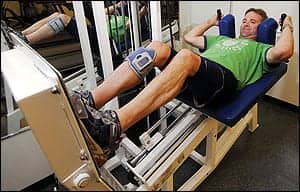Scientists from Ecole Polytechnique Fédérale de Lausanne in Switzerland suggest that phantom pain in paraplegics can be lessened by using virtual reality to create an illusion that the paralyzed legs are being touched again.
“We managed to provoke an illusion: the illusion that the subject’s legs were being lightly tapped, when in fact the subject was actually being tapped on the back, above the spinal cord lesion,” explains neuroscientist Olaf Blanke, lead author of the study, published in Neurology.
“When we did this, the subjects also reported that their pain had diminished,” adds Blanke, holder of the Foundation Bertarelli Chair in Cognitive Neuroprosthetics, in a media release from Ecole Polytechnique Fédérale de Lausanne.
“We tapped the back of the subject near the shoulders and the subject experienced the illusion that the tapping originated from the paralyzed legs,” explains Polona Pozeg, co-author of the study and now neuroscientist at the Lausanne University Hospital (CHUV), in the release. “This is because the subject also received visual stimuli of dummy legs being tapped, viewed through the virtual reality headset, so the subject saw them immersively as his or her own legs.”
The experimental setup involves a pair of dummy legs, a camera, virtual reality goggles and two rods. The legs are filmed by a camera. In real-time, the video is relayed into virtual reality goggles worn by the paraplegic patient. The subject sees the dummy legs viewed from above, as if looking down on one’s owns legs. With this setup in place, the scientist taps the patient’s back with one rod while simultaneously tapping the dummy legs with the other.
The subject therefore receives two stimuli, one tactile on the back, the other visual from the virutal reality display. Despite being consciously aware of being tapped on the back, the subject still begins to feel as though the tapping comes from the paralyzed legs, the release explains.
“It takes about a minutes of simultaneously tapping for the illusion to take place,” Blanke says. “The tapping on the back gets translated onto the legs because the visual stimulus dominates over the tactile one.”
The research pushes the limits of how virtual reality can be used to implement conflicting stimuli, with the aim of ultimately manipulating the brain in how it experiences the body for therapeutic reasons.
Based on these findings, the researchers are currently developing virtual reality technology that automatizes visuo-tactile stimulations—an immersive digital therapy—for regular use at home by individuals with spinal cord injury and other chronic pain conditions.
[Source(s): Ecole Polytechnique Fédérale de Lausanne, Science Daily]





